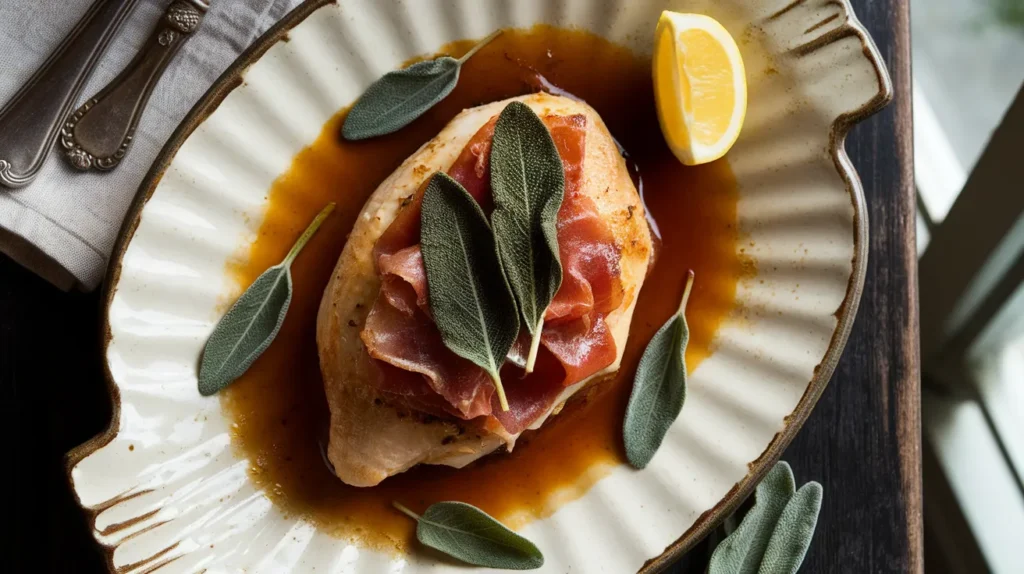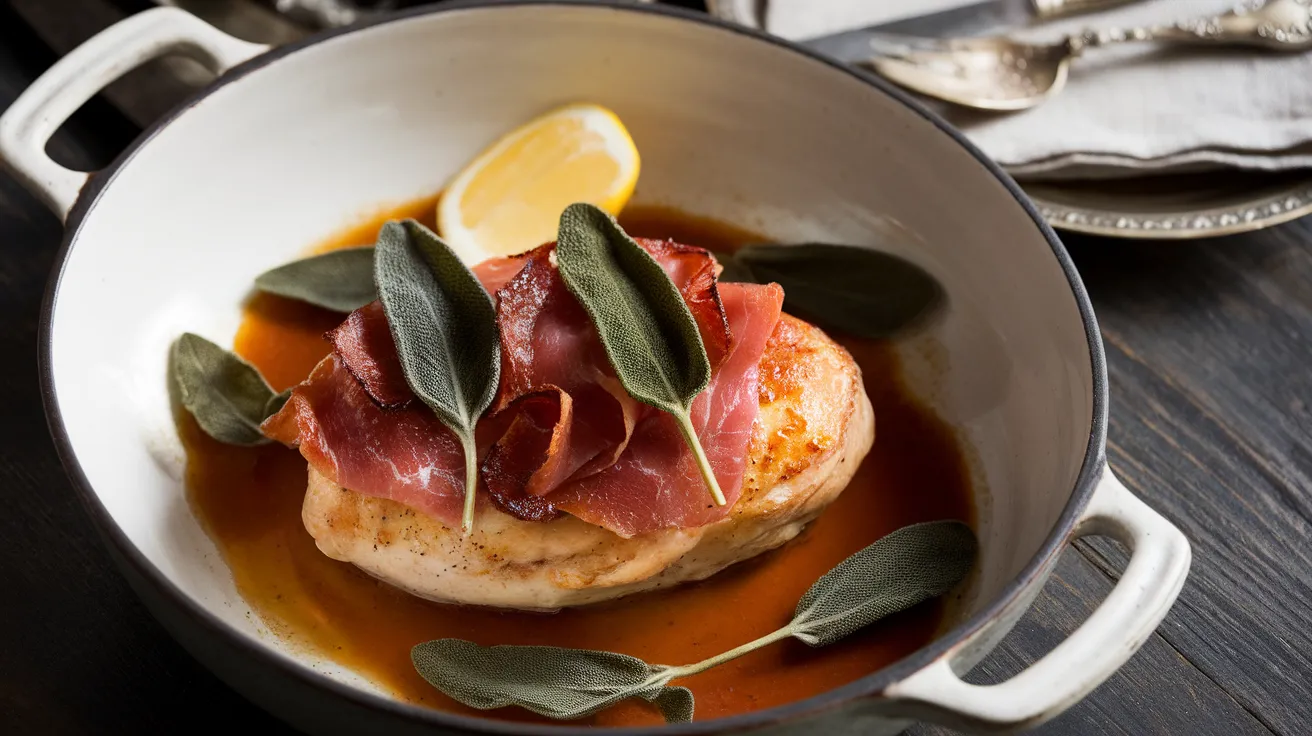Crispy prosciutto-wrapped chicken topped with fresh sage creates this classic Roman dish that’s surprisingly simple to master. This chicken saltimbocca delivers restaurant-worthy results in just 30 minutes, making it perfect for both weeknight dinners and special occasions.
SERVES: 4 | PREP: 15 MIN | COOK: 15 MIN | TOTAL: 30 MIN
What Makes Chicken Saltimbocca Special
The name literally means “jump in the mouth” in Italian, and one bite explains why.
Tender chicken breast meets salty prosciutto and aromatic sage in a buttery white wine sauce. The combination is pure magic.
I’ve been making this dish for years, and it never fails to impress. The secret is getting that prosciutto perfectly crispy while keeping the chicken juicy.
Ingredients You’ll Need
For the Chicken
| Ingredient | Amount |
|---|---|
| Boneless, skinless chicken breasts | 4 pieces (6-8 oz each) |
| Prosciutto slices | 8 thin slices |
| Fresh sage leaves | 16-20 leaves |
| All-purpose flour | ½ cup |
| Salt | ½ teaspoon |
| Black pepper | ¼ teaspoon |
| Olive oil | 2 tablespoons |
| Butter | 3 tablespoons (divided) |
For the Pan Sauce
| Ingredient | Amount |
|---|---|
| Dry white wine | ¾ cup |
| Chicken broth | ½ cup |
| Fresh lemon juice | 2 tablespoons |
| Butter | 1 tablespoon (for finishing) |
Step-by-Step Instructions
Phase 1: Preparing the Chicken (5 minutes)
Step 1: Place each chicken breast between two sheets of plastic wrap. Using a meat mallet or heavy skillet, pound to ½-inch thickness. This ensures even cooking and creates the perfect surface for the prosciutto to adhere.
Step 2: Pat the chicken completely dry with paper towels. Any moisture will prevent proper browning and make the prosciutto soggy instead of crispy.
Step 3: Season both sides of each chicken breast with salt and pepper. Don’t overdo the salt—the prosciutto adds plenty of saltiness.
Step 4: Lay 2 slices of prosciutto on each chicken breast, slightly overlapping them. The prosciutto should cover most of the surface.
Step 5: Place 4-5 fresh sage leaves on top of the prosciutto, pressing them gently to help them stick. The sage will crisp up beautifully during cooking.
Step 6: Thread 2-3 toothpicks through each chicken breast to secure the prosciutto and sage. Insert them at an angle so they hold everything together without tearing through.
Phase 2: Dredging and Searing (8 minutes)
Step 7: Spread the flour on a large plate. Dredge each chicken breast in flour, coating only the side without prosciutto. Shake off excess flour—too much creates a gummy coating.
Step 8: Heat 2 tablespoons olive oil and 2 tablespoons butter in a large skillet over medium-high heat. The pan is ready when a pinch of flour sizzles immediately upon contact.
Step 9: Place chicken breasts in the pan prosciutto-side down. Don’t move them for 3-4 minutes. You’ll hear a satisfying sizzle—this is the prosciutto getting crispy and the sage releasing its oils.
Step 10: Flip the chicken carefully using two spatulas to prevent the prosciutto from sliding off. Cook the other side for 3-4 minutes until golden brown and the internal temperature reaches 165°F.
Step 11: Transfer the chicken saltimbocca to a warm plate and tent loosely with foil. Don’t remove the toothpicks yet—they’ll help keep everything together.
Phase 3: Building the Pan Sauce (7 minutes)
Step 12: Pour the white wine into the hot skillet, scraping up all the browned bits from the bottom with a wooden spoon. These bits are pure flavor gold.
Step 13: Let the wine bubble vigorously for 2-3 minutes until reduced by half. You should be able to draw a line through it with your spoon that holds for a second.
Step 14: Add the chicken broth and bring to a simmer. Cook for 2 minutes until the sauce thickens slightly and coats the back of a spoon.
Step 15: Remove from heat and stir in 1 tablespoon butter and lemon juice. The butter adds silky richness while the lemon brightens everything up.
Step 16: Remove toothpicks from the chicken, return the breasts to the pan, and spoon sauce over top. Let rest for 1 minute to allow the flavors to meld.
Chef’s Notes
Prosciutto Quality Matters: Use authentic Italian prosciutto di Parma for the best flavor. The paper-thin slices crisp up perfectly and add that signature salty-sweet taste to your chicken saltimbocca.
Wine Selection: Choose a dry white wine you’d actually drink—Pinot Grigio or Sauvignon Blanc work beautifully. The wine’s acidity balances the richness of the butter and prosciutto.
Sage Freshness: Fresh sage is non-negotiable here. Dried sage won’t crisp up and lacks the aromatic punch that makes this dish sing.
Resting Time: Let your chicken rest after cooking. This redistributes the juices throughout the meat, keeping every bite moist and flavorful.
Nutrition Information (Per Serving)
Calories: 385 | Protein: 42g | Carbohydrates: 8g | Fat: 18g | Sodium: 680mg | Fiber: 0.5g
Delicious Variations to Try
Veal Saltimbocca Traditional
Swap chicken for thin veal cutlets for the authentic Roman version. The delicate veal requires 2 minutes per side cooking time.
Marsala-Style Saltimbocca
Replace white wine with Marsala for a sweeter, richer sauce. If you love bold Italian flavors, try our chicken marsala for another crowd-pleaser.
Mushroom Saltimbocca
Add 8 oz sliced cremini mushrooms to the pan sauce. Sauté them before adding the wine for an earthy depth.
Lemon-Caper Version
Stir 2 tablespoons capers into the finished sauce. The briny pop complements the prosciutto beautifully. For more Italian-inspired dishes, our chicken scallopini offers similar elegant simplicity.
Storage & Reheating Guide
Refrigeration: Store leftover chicken saltimbocca in an airtight container for up to 3 days. Keep the sauce separate to prevent the prosciutto from getting soggy.
Freezing: I don’t recommend freezing this dish. The prosciutto loses its texture, and the sage becomes mushy when thawed.
Reheating: Warm in a covered skillet over medium-low heat for 5-7 minutes. Add a splash of chicken broth to revive the sauce. The microwave makes the prosciutto rubbery—avoid it.
Make-Ahead Tip: Prep the chicken with prosciutto and sage up to 4 hours ahead. Cover and refrigerate, then dredge and cook just before serving.

Troubleshooting Common Problems
Problem: Prosciutto Won’t Stay Attached Pat the chicken bone-dry before adding prosciutto. Use enough toothpicks—at least 2-3 per breast. Press the prosciutto firmly onto the chicken before securing.
Problem: Chicken Is Dry You’ve overcooked it. Use an instant-read thermometer and remove from heat at 160°F—carryover cooking brings it to 165°F. Pounding to even thickness prevents thick spots from undercooking while thin areas dry out.
Problem: Sauce Is Too Thin Let the wine reduce longer before adding broth. It should be syrupy and reduced by half. If still thin, simmer the final sauce an extra minute before adding the finishing butter.
Problem: Prosciutto Burns Before Chicken Cooks Your heat is too high. Medium-high should sizzle but not smoke. If the prosciutto is browning too fast, reduce to medium and add 1-2 minutes to cooking time.
Problem: Flour Coating Gets Gummy You’re using too much flour or the pan isn’t hot enough. Shake off excess flour aggressively, and ensure your oil-butter mixture shimmers before adding chicken.
Equipment Essentials
- Large skillet (12-inch stainless steel or cast iron)
- Meat mallet or heavy skillet for pounding
- Plastic wrap for pounding chicken
- Instant-read thermometer
- Wooden spoon for sauce-making
- Two metal spatulas for flipping
- Toothpicks for securing prosciutto
- Tongs for handling chicken
- Measuring cups and spoons
Shopping List (Organized by Store Section)
Meat Counter
- 4 boneless, skinless chicken breasts (6-8 oz each)
- 8 thin slices prosciutto di Parma
Produce
- 1 bunch fresh sage leaves
- 1 lemon
Dairy
- Butter (1 stick)
Pantry
- All-purpose flour
- Olive oil
- Salt and black pepper
Beverages
- 1 bottle dry white wine (Pinot Grigio or Sauvignon Blanc)
- 1 carton chicken broth
Success Secrets from the Kitchen
1. Temperature Control Is Everything Don’t rush the searing. Medium-high heat gives you that golden crust without burning the prosciutto. If you smell burning, immediately reduce heat.
2. Dry Chicken = Crispy Prosciutto Water is the enemy of crispiness. Pat that chicken until your paper towels come away completely dry.
3. Deglaze Like a Pro Pour the wine into the hot pan away from you to avoid steam burns. Scrape every brown bit—that’s where the flavor lives.
4. Rest Before Serving Those 60 seconds of resting make the difference between okay chicken and restaurant-quality chicken saltimbocca. The juices redistribute, and the temperature evens out.
5. Fresh Ingredients, Fresh Taste This simple dish relies on quality. Splurge on good prosciutto and fresh sage. You’ll taste the difference in every bite.
Your chicken saltimbocca journey starts now—and trust me, once you master this Italian classic, it’ll become your go-to impressive dinner that’s secretly simple to make.




